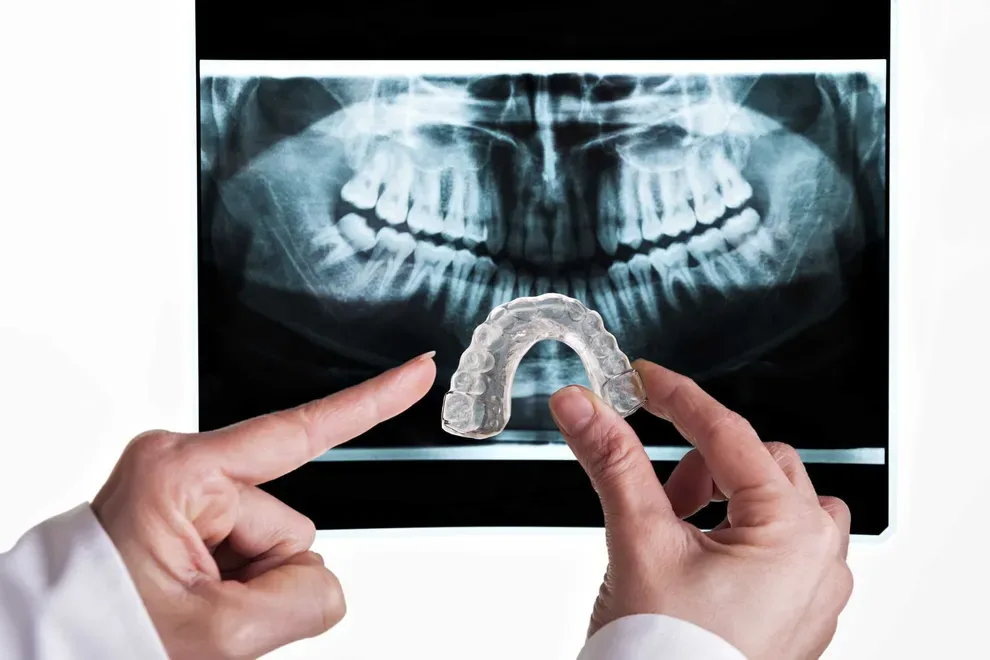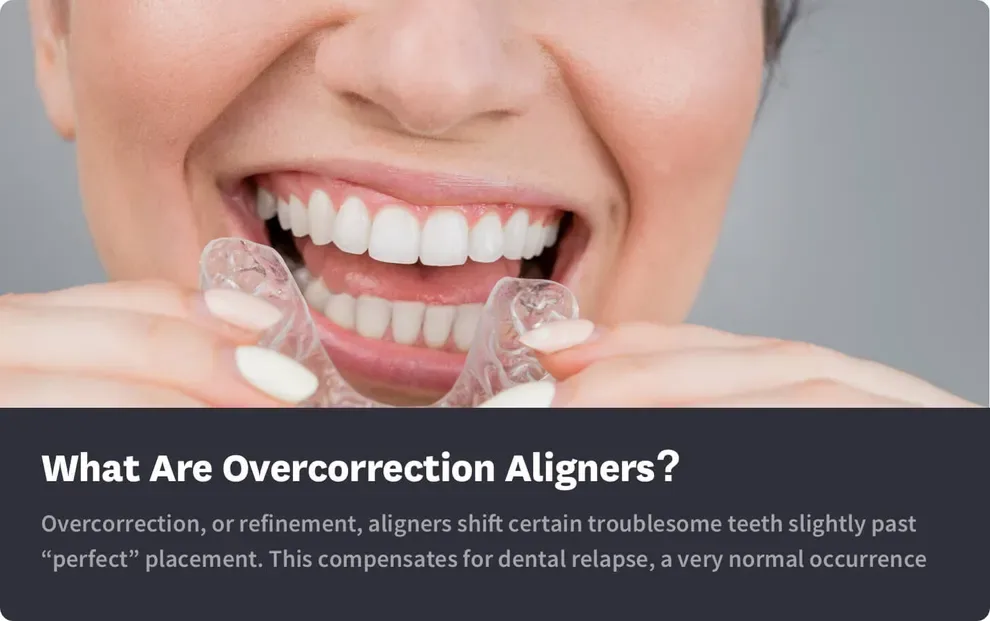Overcorrection Aligners: How They Work & Their Effectiveness

Table of Contents
- What Are Overcorrection Aligners?
- How They Work
- Effectiveness
- Do I Need Them?
- Frequently Asked Questions
- References
Overcorrection aligners, also called refinement aligners, are designed to adjust specific teeth in your mouth into a position just past perfect alignment.
Sometimes, certain teeth are determined to be more likely to become misaligned quickly after orthodontic treatment. Overcorrecting these teeth ensures they remain in better alignment if they begin to shift.

What Are Overcorrection Aligners?
When you are working to align your teeth and get a smile you love, the term overcorrection may seem unsettling. However, overcorrection might be an important part of your treatment with clear plastic aligners.
Just like retainers, overcorrection aligners help to keep your smile beautiful. Unlike retainers, overcorrection aligners are not designed to hold your teeth in place after they have been properly aligned.
Overcorrection, or refinement, aligners shift certain troublesome teeth slightly past “perfect” placement. This procedure compensates for dental relapse, which is a very normal occurrence. Everyone’s teeth shift throughout their lives, and by identifying teeth that may begin shifting sooner or more extremely than others, your telehealth dentist can ensure you get the best results from your clear aligner treatment.
How Do Overcorrection Aligners Work?
Refinement or overcorrection aligners are becoming an increasingly common part of aligner treatment. Clear plastic aligners are an excellent treatment option for a wide range of dental misalignments, although some treatment may require more time or more trays, depending on your dental needs.

For some people, their orthodontist or dentist may recommend overcorrection aligners. Sometimes, they may provide these treatments as part of your final set of trays and let you know that you do not need to wear them if you do not want to. However, supplying overcorrection aligners can help you keep great alignment for longer.
Who Is a Candidate?
Refinement or overcorrection aligners may be provided to reduce shifting teeth that may be prone to these issues:
Rotations
Forward movement from tongue thrusting
Expansion or gapping
Extrusion
In order to properly determine if you need overcorrection aligners, talk to the supervising orthodontist or dentist about the process when you ask about aligner treatment. You can either pay for this advanced service to be included, as in services like Invisalign, or you can request an examination to determine if your teeth might benefit from overcorrection aligners. The dentist will then:
Examine the scans or impressions of your teeth to decide which teeth may need “overcorrection.”
Determine how these teeth might shift over time.
Structure overcorrection with a final set of clear plastic aligners.
Most dentists who work with clear plastic aligners use computer software to create a digital version of your dental alignment. They then study how to create personalized aligners that will help shift your teeth into their best possible position.
Since clear plastic aligners do not apply the same type of force that traditional metal braces use, your teeth may need further support to remain in this alignment once you have finished the trays provided. This additional treatment can take between three and five weeks, depending on how many teeth need refinement or overcorrection and how serious the original misalignment was.
Backtracking may be suggested as part of your treatment to get the teeth back on track by having the patient wear a preliminary aligner longer before moving to the next part of treatment.
Are Overcorrection Aligners Effective?
One example of recommended overcorrection involves adjusting the inclination of your teeth about 10 degrees further inward for people who have overjet issues. Dental research suggests that rotations, intrusions, and similar dental problems should be included in the overcorrection plan as standard tray alignment may not be fully expressed when you are done wearing the tray. One medical study found that movements responded to overcorrection 28 to 56 percent of the time, with an average of 50 percent responding to overcorrection treatment.
It is recommended that you ask about potential overcorrection or refinement needs during your appointment with your orthodontist or dentist, whether this is in person or through a telehealth service. It is important not to skip overcorrection aligners that have been provided, as they help to stabilize the teeth in need of refinement, which supports long-term stability for your perfect smile. Most teeth respond well to this type of treatment.
Although it is often part of the first stages of orthodontic treatment with clear aligners, your dentist may also retake some impressions or scans of your teeth toward the end of your treatment to ensure your teeth are moving into the right places. If your teeth are not responding fully to treatment with the existing trays, your orthodontist or dentist may provide overcorrection aligners to help.
Do I Really Need Overcorrection Aligners?
If you have moderate or severe dental misalignment, you may not avoid overcorrection treatment, which can extend your overall orthodontic treatment for several weeks. However, if you do want to reduce your need for overcorrection trays, it is important to follow the treatment plan your orthodontist or dentist sets out for you.
This means wearing each set of your regular aligners for their recommended length of time, which is typically about two weeks, for about 22 hours per day. Forgetting to wear them for the full 22 hours once in a while is not likely to harm your alignment, but inconsistent wear means your teeth will not shift with your standard treatment as designed.
While you may not have discussed overcorrection aligners at first, you can ask about them if you are part of the way through your clear aligner treatment, especially if you are not getting the alignment results you want. Your orthodontist or dentist may need new scans or impressions of your teeth, and it can take one to two months to make overcorrection aligners.
As you wait, it is recommended that you do not stop wearing your existing aligner, so you do not experience any misalignment or shifting while you wait for the new aligner set. Once you have overcorrection aligners, you may also receive new retainer aligners, which will help your teeth settle into their new position and maintain proper alignment.
Overcorrection Aligner FAQs
Refinement aligners will come with your treatment trays. They may be marked differently, so you know they are a secondary stage of treatment.
Your instructions will show the ideal shifting of your teeth and tell you about any needs for overcorrection or refinement that you have.
Orthodontists or dentists who examine your photos and dental molds will use the latest technology to virtually shift your teeth into perfect alignment, to design clear aligners for you. As they do this, they will also look at specific teeth to determine if these are at risk of shifting soon after reaching ideal alignment. They will then design refinement aligners to manage this issue.
Overcorrection aligners add an additional few weeks to your treatment.
The exact amount of time required depends on how much your orthodontist or dentist decides is needed to reduce the risk of teeth shifting. This can range from two weeks to three months, but it will not be as long as you wear your first round of clear aligners for.
Without necessary refinement aligners, your teeth are at risk of shifting out of proper alignment fairly soon after your initial treatment is complete. You may find you need or want another round of clear aligner treatment in a year or two, and this will take longer and cost more than simply wearing the refinement aligners.
If you have concerns about overcorrecting certain teeth, ask your orthodontist, dentist, or aligner treatment company about the process. They can give you details about why certain areas have been targeted, which can put your mind at ease.
Overcorrection is planned, and it is not the same as crooked or misaligned teeth. While having misaligned teeth can cause damage to your oral health, wearing refinement aligners for overcorrection actually keeps your teeth healthier for longer.
Damage is unlikely with clear aligner treatment, including overcorrection aligners, but if you wear them improperly, like skipping ahead to a different aligner, you can damage your teeth. If you enjoy too many hot foods or drinks, this can warp the aligner, which can also damage your teeth. If you do not practice good oral hygiene, any food trapped under your aligners can increase the risk of tooth decay, which might damage your teeth.
However, if you follow instructions and practice good oral hygiene, you will have a beautiful smile very soon.
No, overcorrection aligners are a separate step in your orthodontics process that will occur before you wear a retainer.
If you receive a retainer with your clear aligner trays, this device can be worn fewer hours of the day — often, just while you sleep — and helps to keep your teeth in proper alignment. In contrast, refinement aligners shift your teeth slightly past ideal alignment to ensure these teeth, as they shift after orthodontics, will remain closer to ideal alignment.
